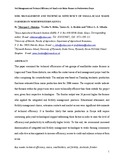| dc.description.abstract | This paper examined the technical efficiencies of two groups of smallholder maize farmers in
Lugari and Trans Nzioa districts, one within the contact areas of soil management project and the
other comprising the counterfactuals. The analysis was based on Translog stochastic production
functions estimated from maize production data for 2006 season. The empirical results indicate
that farmers within the project area were more technically efficient than those outside the project
area, given their respective technologies. The frontier output was 26 percent higher for farmers
who applied the integrated soil fertility management practices. Educational attainment, soil
fertility management choice, extension contacts and market access were significant determinants
of technical efficiency. It is therefore likely that maize production in Kenya will require
continuing policy and technological support addressing these factors in order to raise the level of
efficiency and productivity to sufficiently higher levels. To this end, we recommend increased
dissemination of integrated soil fertility management technologies to wider farming community
and collective action approach to increase efficiency, access to credit and enhance returns at farm
levels. | en |

